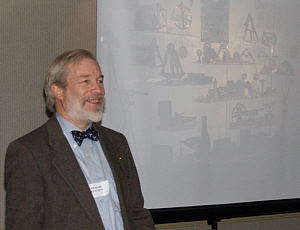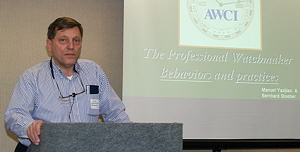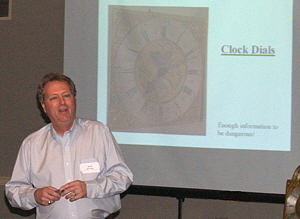FALL MEETING, SUNDAY, OCTOBER 29, 2006
Worcester Hotel & Conference Center
(meeting highlights & Joe Brown testimonial below pictures)

Richard Ketchen presenting "The Precision Clocks in the Collection of Historical Scientific Instruments at Harvard University"

Jack Kurdzionak presenting "The Watchmaker in the 21st Century"

Don Irving presenting "Evolution Of The Clock Dial"
Highlights by Dick Trepp
The fall meeting of Chapter 8, at The Worcester Hotel & Convention Center on October 29th brought out 150 members for a full slate of activities. In addition to the usual silent auction, 50-50 raffle and an active mart, the chapter was delighted to have three members presenting the educational programs. And varied they were.
Richard Ketchen speaking from his personal knowledge and as a restorer for Harvard University presented a slide show "The Precision Clocks in the Collection of Historical Scientific Instruments at Harvard University." These clocks and instruments are housed in the Science Center. Many are in private offices and are still used by the faculty. Additional rarities are in a setting at the Center open to the public. David Wheatland, in 1940, started to put this collection together. Others followed him but only the choicest clocks were amassed. Among them are a 1665-85 Tompion, an English Ellicott about 1765-1840, and a very accurate Simon Willard Jr. 1832 tall case clock. Then there are the early 20th century Shortt clocks with their pendulums operating in a vacuum. A unique clock by Wm. Bond, a Howard #74 regulator, and a massive but delicate Simon Willard are also in the collection.
"The Watchmaker in the 21st Century", a power point presentation by Jack Kurdzionak was really a hard look at the decline in watchmakers and what all the concerned groups did to resolve the problem. An enthusiastic speaker who has been involved in almost all aspects of improving the situation, Jack pointed out that during the 50's, 60's and 70's, there was a drop from 50000 to 5000 professional watchmakers.
Schools declined to about 29 in this country. By joint efforts of the watch manufactures, the AWCI, and a Swiss group called Watchmakers of Switzerland Training and Education Program (WOSTEP), standards were set, schools started, and exams administered, all with the end goal of creating certified watchmakers. Many of the schools were brand oriented. Rolex has a program to turn out watchmakers particularly skilled to service Rolexes. These special industry schools employ as many of their graduates as they can. In addition, Jack put great emphasis on the need of the new professional to make a sterling first impression with their potential customers. Cleanliness, proper dress, clean work areas, and neat storage facilities were shown by example on the screen, as well as many horror shots of what not to do. With proper training, Jack feels that new young watchmaker today can make a good living.
Our luncheon program, "Evolution of the Clock Dial" a beautifully researched talk on the development of dials, by Don Irving, was enhanced by slides and a display of some of the dials. The emphasis was on the evolution of the clock dial as a means to meet the needs of people, rather than on the technical aspect of fabrication of dials. Starting about 4000 years ago, Don talked about the Egyptian Calendar. Then came the solar year split into 12 parts and the lunar cycle, marking a passage of 30 days. The days and nights were split into 12 divisions. Along came the Sundial. This does not measure time but a water or sand clock could do this. The need to tell time at sea brought about a real effort to improve on telling time. During the 14th century the church had needs that resulted in alarm clocks to alert someone, who in turn could the alert others to meet their religious obligations. As people moved from isolated farms to the city, there was more need to provide an ability to attend functions and other meetings. Along came the first tower clocks in the late 14th century. These measured time for all to see. In the 16th century we find bracket clocks for portability, and in the 17th, the brass lantern clock. Dials of course, became more refined and complex with each new development. By 1697, we had the conventional hour, minute and seconds hands. During the 1700-1830 period, dials were made with spandrels, minute marks, and variations of these enhancements. To save money, the painted dial was introduced around 1770. And by 1830 even the painting became fancy. Don presented an interesting look into something many take for granted.
-- Dick Trepp
Silver Star Award is presented to Joe Brown
 A significant event for Chapter 8 was a feature of the luncheon. Burt Kassap and Larry Chelmow presented Joe Brown with the Silver Star Award. In 1993, Joe was made a Fellow of the NAWCC. Joe has continued to contribute at a high level to National, Chapter 8, and other horological groups. He has more than earned his Star Fellow Award. A significant event for Chapter 8 was a feature of the luncheon. Burt Kassap and Larry Chelmow presented Joe Brown with the Silver Star Award. In 1993, Joe was made a Fellow of the NAWCC. Joe has continued to contribute at a high level to National, Chapter 8, and other horological groups. He has more than earned his Star Fellow Award.
Joe is a member of New England Chapter 8, Oldtimers and Fellow Chapter #22, International 400 Day Chapter168; and was a member of Greater Mass Chapter 87.
Joe has served as Second Vice President, First Vice President, and President of Chapter 8 from1985 to 1991; has been a Director from 1981 to present; and was a director of Chapter 87 from 1973 to 1976.
Joe is currently on the board of the Willard House and Clock Museum. He has served on numerous committees, chairmanships and leadership roles at the chapter level. Among these are the annual symposium, Willard workshop, and numerous special committees.
On a regional level, he was co-chair of the regional meeting with Chapter 40 at the University of Mass. in 1985. He was on the planning committee for the 1980 National Convention in Boston in 1980 and also served as Assistant Chairman of the watch exhibit. Joe also was a member of the committee that planned and coordinated City of Waltham as part of the National Seminar in 2002.
Since 1972, Joe has given over 100 horological lectures, workshops, and demonstrations. This not only includes local chapters but also museums, civic groups, service clubs, historical societies, and public schools.
Joe is also a volunteer and Board member of the Charles River Museum of Industry in Waltham. He was chairman of the group of Chapter 8 volunteers that maintains their horological collection.
Besides being a Certified AWI Clockmaker, Joe has contributed many articles to the Bulletin.
-- Larry Chelmow
FALL MEETING, SUNDAY, OCTOBER 29, 2006
Worcester Hotel & Conference Center
500 Lincoln St., Worcester MA
508-852-4000
Directions:
Please note: The Worcester Hotel & Conference Center is the new name of the Worcester Holiday Inn location which we have met at many times before.
Click here for Mapquest Map
From the East: Mass Pike 90. Take Exit 11A on to 495 North. Take Exit 25B onto 290 West. Take Exit 20 (Lincoln St.) Bear RIGHT off the ramp onto Lincoln St. The Worcester Hotel will be at a set of lights about ½ mile on the left. Turn left at the lights to enter Inn driveway. There is a Denny's on that corner.
From the West: Mass Pike (90), East: Take Exit 10 onto 290 East. Take Exit 21 (Plantation St.). Take a Left off the ramp on to Plantation St. Proceed straight for about 0.3 mile and at the lights bear left on to Lincoln St. The Worcester Hotel is about 0.7 mile on the right.
From the North: I 93 South to 495 South. Take Exit 25B onto 290 West. Take Exit 20 (Lincoln St.) Bear RIGHT off the ramp onto Lincoln St. The Worcester Hotel will be at a set of lights about ½ mile on the left. Turn left at the lights to enter Inn driveway. There is a Denny's on that corner.
From the South: I 95 North to I 295 North to 146 North to 290 East. Take Exit 21 (Plantation St.). Take a Left off the ramp on to Plantation St. Proceed straight for about 0.3 mile and at the lights bear left on to Lincoln St. The Worcester Hotel is about 0.7 mile on the right.
Registrations for current dues paid members by October 21, 2006 are $20.
Registrations received after October 21, 2006, and "walk-ins" will be $25.
As always, registration includes your luncheon and is required for participation in any of the meeting activities.
MEETING SCHEDULE
| 7:30 AM |
Registration name tags available for those members who preregistered.
Registration table open for "walk-ins". Mart area open for set-up by table holders only. |
| 8:00 AM |
Mart open; with closing at 11:45 A.M. for 12:00 Noon Luncheon.
(a watchman for Mart will be provided) |
| 8:30 AM |
Silent Auction Table will run from 8:30 to 10:15A.M. |
| 9:00 AM |
We are pleased to have Richard Ketchen presenting "The Precision Clocks in the Collection of Historical Scientific Instruments at
Harvard
Universit
y
". The collection covers a wide range of accuracy and a time span of 17th to 21st century. Richard will show pictures of some of these rare items, many of which he has worked on, He will talk about their history and horological significance. Ketchen is a Fellow of the NAWCC, past president of the Greater Boston Watch and Clock Collectors, and a frequent lecturer on technical horology. |
| 10:30 AM |
"The Watchmaker in the 21st Century" Jack Kurdzionak will present a program that traces how watchmaking in America has evolved from the mid 20th century to the present with a focus on the professional watchmaker, his training, workshop practices, and AWCI certification. Jack Kurdzionak, CW, long time Chapter 8 member, is currently serving as a director and treasurer of the American Watchmakers Clockmakers Institute. His thirty-six years of watchmaking experience includes the past 19 as senior watchmaker for "The Watchmaker" in
Stoneham
MA
. Jack has attended watchmaking classes in
Switzerland
,
England
, and the
USA
. His professional affiliations are with the BHI, NAWCC, MWA, and the AWCI. Jack has served AWCI as president, vice president, secretary, director, author, and currently is a member of its Board of Examiners. |
| 11:45 |
Mart closes |
| 12:00 |
Noon Luncheon |
| 12:30 |
Luncheon Program:
"EVOLUTION OF THE CLOCK DIAL" Don Irving will cover how the dial has developed into the form we know now. He will also point out how the changes in society are reflected in these dials. The origin of numerous terms and conventions of time measurement will also be discussed. Don has been repairing clocks for 25 years. He is also an expert wood worker, and combines this background by building or restoring the cases and the movements.
|
The Silent Auction table (8: 30 to 10:15) - enables you to sell a few items without the need for a table:
Fill out a slip at the table with your minimum price you will accept for the item. Members can then write in their bids during the course of the auction.
The cost to you as a seller is only $3.00 PER ITEM. The charge is payable in advance and applies whether item sells or not (multiple items for one bid count as one item).
AND
At at the auction table you can buy a ticket for the 50-50 raffle.
PRESIDENT’S MESSAGE
It is that time of year to enjoy the New England Fall foliage and prepare for the Winter and oncoming holidays. We have made every attempt this year to present to our members interesting presentation speakers and informative horological work shops. We have also provided a means to buy and sell clocks and watches to our members and have had excellent responses to our silent auctions. More important, we have continued to provide opportunities to socialize at our luncheons to develop and promote both horological information and lasting friendships. We have also been fortunate to have new members join our group. We still have plenty of work to do and value your comments and suggestions. My best wishes to all for the oncoming holidays.
-- Burt Kassap |
Suitcase Clock Repair Courses:
Victor Kozakevich, an associate director of Chapter 8, handles the NAWCC Suitcase Program. If you are interested, contact him at a meeting or call him at 617-491-4608. Contact by E-mail is vkozak@att.net.
Workshop Topics:
If you would like to do a workshop presentation or have suggestions for future topics/presenters, please contact Peter Nunes. 401-789-6791 or by email: peter.nunes@verizon.net
Chapter Contacts:
If you any of you have a question or wish to contact someone in the chapter, get in touch with any of these people and they will get your message to the right person if they cannot help you.
President Burton Kassap
112 Bullough Park, Newtonville, MA 02460
617-332-0162
milbur@earthlink.net
1st Vice Pres. VACANT
2nd Vice Pres. Harold Lincoln
5 Ringbolt Road, Hingham, MA 02043
781-740-1190
hgyl@aol.com
Treasurer Wayne Paskerian
5 Warren St., Winchester, MA 01890
781-729-0113
winway@comcast.net
Acting Secretary Dick Tripp
573 Longmeadow St., Longmeadow, MA 01106
413-567-0771
rgtrepp@verizon.net
2005 Past President Dave Deutermann
81 Kingman St, Lakeville, MA 02347
508-946-1082
davmardeut@tmlp.com
2007 Director Joe Brown
7 Pheasant Ave. Sudbury, MA 01776
978-443-2284
brown07@rcn.com
2007 Director Larry Chelmow
399 Chapman St., Canton, MA 02021
781-828-1626
chelmowl@yahoo.com
2007 Director Peter Nunes
4 Hopkins Lane, Peace Dale, RI 02879
401-789-6791
peter.nunes@verizon.net
2009 Director Les Tyrala
28 Curtis St. Quincy, MA 02169
617-479-2140
geoclock@msn.com
2009 Director Frank Menez
2 Bernier St. Somersworth NH 03878
603-692-0499
fmenez@comcast.net
2009 Director Martin Cohen
21 Dunbarton Rd, Belmont, MA 02478
617-484-8725
banjoengineer@aol.com
Associate Director Victor Kozakevich
44 Sherman St., Cambridge, MA 02138
617-491-4608
vkozak@att.net
|



 A significant event for Chapter 8 was a feature of the luncheon. Burt Kassap and Larry Chelmow presented Joe Brown with the Silver Star Award. In 1993, Joe was made a Fellow of the NAWCC. Joe has continued to contribute at a high level to National, Chapter 8, and other horological groups. He has more than earned his Star Fellow Award.
A significant event for Chapter 8 was a feature of the luncheon. Burt Kassap and Larry Chelmow presented Joe Brown with the Silver Star Award. In 1993, Joe was made a Fellow of the NAWCC. Joe has continued to contribute at a high level to National, Chapter 8, and other horological groups. He has more than earned his Star Fellow Award.